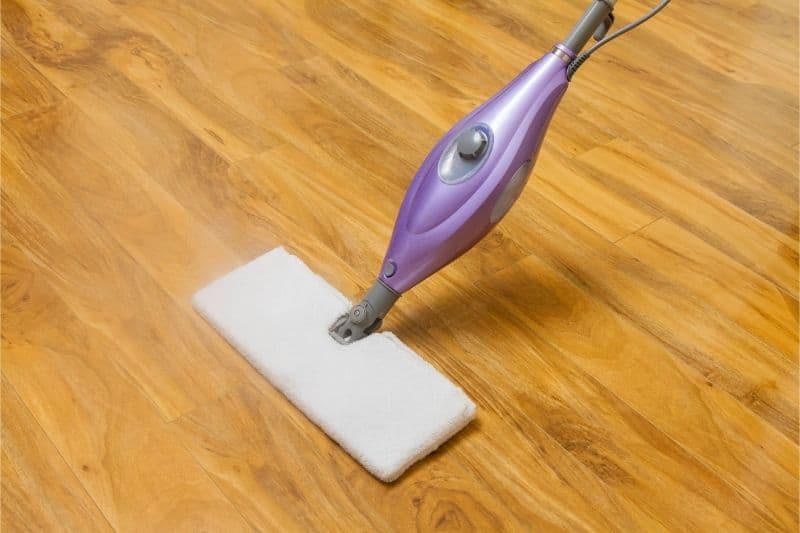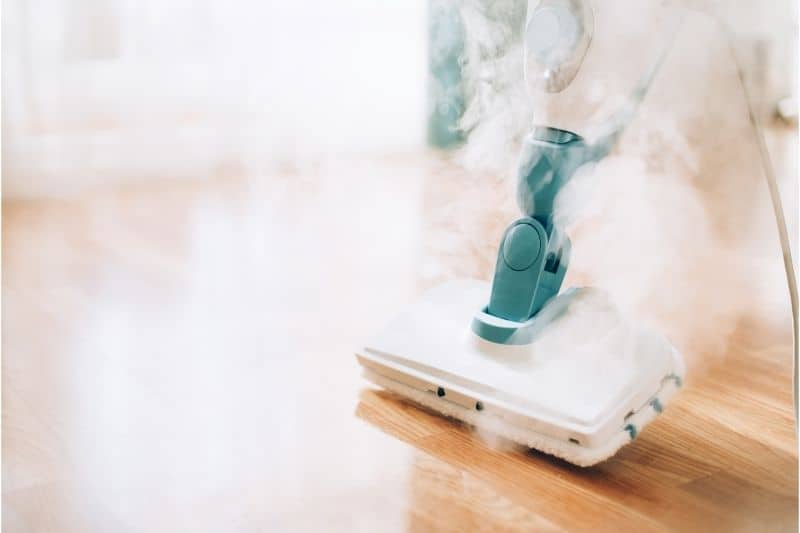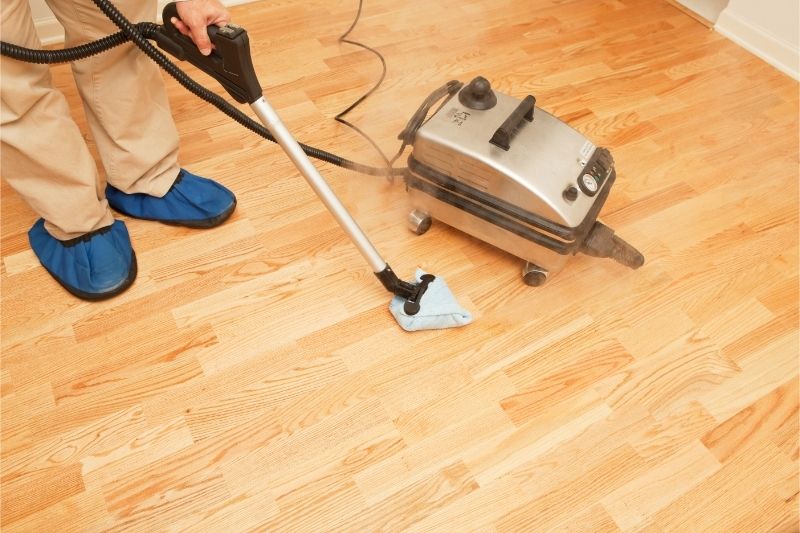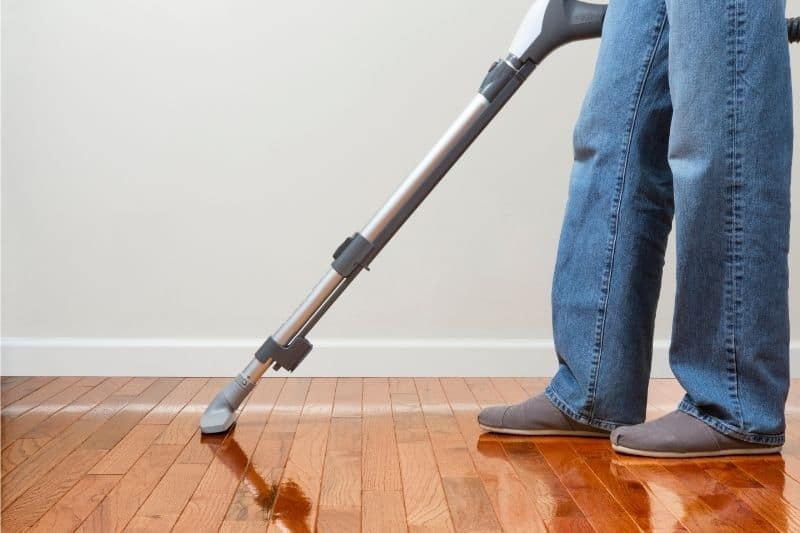“Can I use a steam mop on hardwood floors?” This is one of the most common questions that people ask. The answer, however, is not so easy. There are many factors to consider before using a steam mop on your hardwood floors. We will discuss some of these factors and show you how you can make an informed decision about whether or not to use a steam mop on your hardwood flooring!

Why Use the Power of Steam?
We all want a clean home, which is why steam cleaning can be such an effective method to remove stubborn dirt and stains. In addition to being natural and non-toxic for your family’s health, it also kills 99.9% of household germs including E coli, salmonella, Staphylococcus bacteria as well as surface mold and dust mites!
There are other benefits too: you could use the power of steam in any number of ways in your home; from ovens or grills to furniture with upholstery that needs deep cleaning…whatever suits you best because there’s no one better than steam when it comes getting things spotless inside and out!
This then brings us to the main question.
Can I Use a Steam Mop on Hardwood Floors?
No, steam mops are not a good idea for hardwood floors. Although it may seem like they are doing the trick, the damage will accumulate in no time at all—often within just one go! The heat from these cleaners damages wood finish and the steam penetrates into their surface much better than water or cleaning solution ever could.
In fact, many flooring experts warn that steam can damage all types of floors—that includes engineered wood flooring, solid hardwood and laminate boards. In general, it is best to avoid water entirely when cleaning wooden floors.
Sure, there are some steam mops that advertise themselves as being hardwood-floor friendly but you should always be skeptical about this. These so-called “hardwood-friendly” products promise to absorb excess water after cleaning and dry the floor in no time at all—does it really work though?

Why You Shouldn’t Use a Steam Mop on Wood Floors
Steam mop causes wood floors to swell
As water seeps through the cracks in wood flooring, it soaks into unfinished wood below and causes boards to swell. The edges of these tightly assembled boards can curl upward as a result—this is called cupping.
Imagine your floor’s top layer turning into a deep valley, the wood underneath buckling and popping up. That is what happens to hardwood floors after they’re exposed to too much moisture when it comes time for them to dry out.
The good news? Repairing cupped boards on hardwoods can be done with sandpaper and some new finish—but that won’t work if you have laminate or engineered floors (or worse, both). In those cases, replacing damaged boards should do the trick.
Steam deeply penetrates wood floors
Mopping with water, followed by a thorough drying can prevent most damage to your hardwood floor. If you use a steam mop; however, the effects are cumulative.
The steam from a mop is powerful enough to push dirt out of the way and penetrate cracks in the wood. After just one or two uses on hardwood, you might not notice any problems but over time this will become an issue that needs attention. Laminate floors are affected more quickly because it’s made up of fiberboard which soaks up water much easier than solid hardwood flooring does.
Steam mop stains the wood floors

By now we’re all familiar with the dangers of wet steam, but it can pose a threat even without penetrating through to your floor. If you have worn or unfinished surfaces on your floor plankings, applying steam may cause water-stained spots that are difficult to remove and need sanding for repair.
Using steam can void the wood floors’ warranty
With most hardwood flooring, there is a manufacturer’s or retailer’s warranty. This will outline the conditions under which it should last and guarantees its replacement if the material fails due to structural problems. There are often explicit conditions about what acts void protection—read carefully to find out if steam cleaning falls into any of these categories for your specific floors!
Be Careful If Using a Steam Mop on Hardwood Floors
I wouldn’t if I were you, but if you do use a steam mop on your hardwood floor, make sure that the flooring is sealed. Do not use a steam mop on unsealed hardwood floors.

A good way to test the seal protecting your hardwood floor is by dripping water onto its surface. If it beads up, then you know that the wood cannot be penetrated and this means that the seal has held strong against any damage done from liquids or steam.
However, if the droplet spreads out or sinks into these surfaces of wood at all—even just a little bit—then there’s no denying what might have happened under those sealed finishes; they’ve been compromised as well!
With seals being so crucial in keeping moisture away from floors such as yours here, make sure (if need be) to get them reapplied before things start falling apart completely on their own.
Also, it is important to adjust the steam mop to the lowest setting and not let the steam hover over one spot for too long.
You also do not want to steam mop the floors soon after waxing. The heat from the steamer will melt away your fresh coat of wax and leave you with a sticky floor to clean up later.
What is the Best Way to Clean Hardwood Floors?
So if you cannot use a steam mop, what to do with your dirty hardwood floor? There are tons of options for keeping it clean without damaging it. Here’s the inside scoop on all our favorite cleaning techniques and which ones you should use!
Sweeping
So, you’re wondering how to properly sweep your hardwood floor, huh? Well if it’s every day that could be a little excessive. The perfect solution would be sweeping with a brush at least twice per week since this will really keep the dust and debris level down while still giving you enough time in between deep cleans when needed.
Vacuuming

Vacuum your hardwood floors with caution. The beater bar on some vacuums can physically damage wood flooring when it is turned on, so make sure to turn the beater bar off before sweeping them up. If you don’t have a vacuum cleaner without that feature or one where you could disable the brush roller, skip this cleaning option entirely.
Using hardwood cleaner
If your hardwood floors look dull, there are a variety of floor cleaners available that can be used to keep them looking shiny and beautiful. The best way to approach it is with a damp cloth or microfiber mop head which will allow you to brush over the surface gently without scratching them too much.
Some safe alternatives out there include brands such as Bona® and Pledge® which offer specialized products designed just for cleaning hardwood floors without damaging them.
Conclusion
In conclusion, using a steam mop on floors can be a great way to clean them and keep the dust and grime off of your surfaces. It will sanitize much better than if you use just water alone, but it’s not recommended for hardwood floors without first testing in an inconspicuous area.

